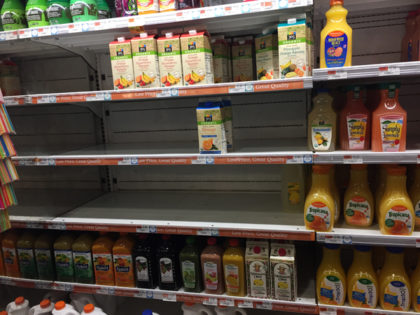In the News: Explanation for Shortages at Whole Foods
 ••• “Whole Foods employees say stores are suffering from food shortages because of a newly implemented inventory-management system called order-to-shelf, or OTS. Whole Foods says the system reduces unnecessary inventory, lowers costs, and frees up employees to focus on customer service. Employees acknowledge that less food is spoiling in storage rooms, but they describe OTS as a ‘militaristic’ system that crushes morale and leads to many items being out of stock. ‘Last week, we ran out of onions and potatoes twice,’ an employee of a Brooklyn Whole Foods store said. ‘Entire aisles are empty at times.'” […] Whole Foods employees say the problems began before the acquisition” by Amazon. (Above: A photo by A. from December.) —Business Insider
••• “Whole Foods employees say stores are suffering from food shortages because of a newly implemented inventory-management system called order-to-shelf, or OTS. Whole Foods says the system reduces unnecessary inventory, lowers costs, and frees up employees to focus on customer service. Employees acknowledge that less food is spoiling in storage rooms, but they describe OTS as a ‘militaristic’ system that crushes morale and leads to many items being out of stock. ‘Last week, we ran out of onions and potatoes twice,’ an employee of a Brooklyn Whole Foods store said. ‘Entire aisles are empty at times.'” […] Whole Foods employees say the problems began before the acquisition” by Amazon. (Above: A photo by A. from December.) —Business Insider
••• Even if you already know Ilysa Winick’s story, the Tribeca Trib‘s recounting—in her and her husband, Steve’s, words—is worth reading. “I can feed myself, brush my teeth, wash my face, write emails. I can use a fork, hold a Starbucks cup without crushing it. I can cook. But as many tricks as I’ve learned, I can’t hold my child’s hand and feel a response. That’s really hard, and I can never replace that.”
••• “The year that just ended was a banner season for Governors Island, according to Michael Samuelian, president of the Trust for Governors Island. […] Together, Manhattan and Brooklyn account for more than half of all the visitors to the park, but Mr. Samuelian expects this to balance to shift somewhat next year, because an additional pier (vacated by the National Park Service, which also has an outpost on Governors Island) has allowed the Trust to begin welcoming ferries from the City-wide system, rather than just the dedicated lines from the two closest boroughs, which was the case in years past. […] In 2019, the Trust for Governors Island plans to launch a new ferry, with the capacity to bring 1,000 visitors per hour to and from the Island.” —Broadsheet
••• Thefts—including a mugging at gunpoint on the subway—in the Tribeca Trib po-po blotter.
••• “Cuomo’s Congestion Pricing for New York City Begins to Take Shape. […] The governor ruled out new bridge tolls in favor of creating a geographic zone where drivers would be charged fees depending on their vehicle and the time of day.” —New York Times













“In the past, if a Whole Foods store ran out of a specific product, employees would fill the hole on the shelf by putting another item – typically one of the store’s top sellers – in its place. The grocery industry calls this practice a ‘face over’ or ‘re-facing.’
“That way, even when stores are short on products, the shelves still appear well-stocked and organized.
“But under an inventory system called order-to-shelf, or OTS, Whole Foods has banned that practice – leaving what one employee described as “gaping holes” on store shelves.
“‘Never ‘face over’ or cover holes,’ the company instructs employees in a 42-page internal manual reviewed by Business Insider. The document describes standard operating procedures for order-to-shelf. The system also bans the use of ‘temporarily out’ tags, it says.
“‘Temporarily out tags are often inaccurate and clutters shelves,’ the manual states. Employees ‘can communicate with customers on status of product rather than a tag.’
“The manual explains why employees should leave holes empty, saying it ‘helps ensure that OOS [out-of-stock] items get reordered because hole is visible, increases the likelihood that OOS [out-of-stock] items will return to in-stock position when available, eliminates confusion for both customers and [employees],’ and ‘makes stock position obvious to customers, [employees], and store leadership.'”
http://www.businessinsider.com/whole-foods-internal-documents-on-empty-shelves-2018-1
congestion pricing will not work if London is an example.
the money pays the costs with little left over.
The London congestion surcharge does, now provide a surplus of about 164 million UK pounds annually and has reduced congestion and pollution. It would be an exaggeration to say it does not work although the initial set up costs were high in this case, but don’t need to be. Because of NYC geography plus lessons learned from other cities we ought to be able to devise a better system than anywhere in the world although experience with MetroCard and EZ Pass don’t inspire confidence.
I do not understand why residents of Manhattan below 60th Street that own a car will have to pay the congestion tax. It’s simply unfair.
Those same car-owning residents get an 8% parking tax reduction–equal to about 1 month of free parking–if they garage their car and register it in New York. (Those who illegally register it at their 2nd home get an undeserved reduction in their auto insurance premium instead.) Residents who park on the street they get free-to-low-cost metered parking at a cost far below garage rates for Manhattan south of 60th Street, also subsidized by the City and its taxpayers and commuters and other business parkers.
Having a car is not a necessity for most people in Manhattan south of 60th Street. A 2009 Department of City Planning survey found “only 23 percent of Manhattan Core households have a car (compared with 46 percent Citywide), and only about one-fifth of those households commute to work by car.”
If London is any guide, residents who register their cars in Manhattan south of 60th Street will get substantial discounts on congestion pricing, which typically applies only when entering the congestion zone.
Anyone who drives a private auto into the Central Business District will pay the same congestion charge, though the amount will vary with day of week and time of day, with a max of $11.50 and a minimum that may even be zero (in the middle of the night, say).
What would be unfair would be to exempt any particular resident’s vehicle, based on location, income, connections, etc. Driving into the CBD causes immense congestion costs (indeed, *that* is the “congestion tax” you decry).
In return, you (and I too) get the likelihood of a faster and more reliable trip, whether by car (since there will be fewer of them clogging the streets) or bus (since fewer cars) or train (since the revenues — which, unlike in London, will be substantial, as Bob noted in his comment — can be invested in better subway service.
Seems like a good deal for just about everyone.